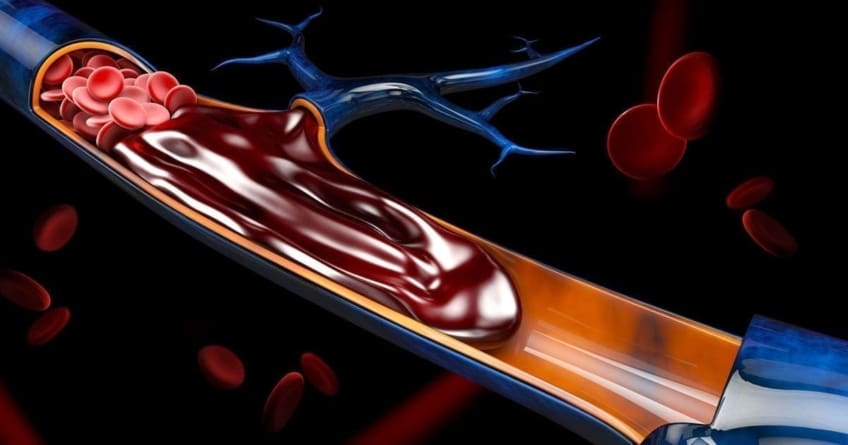
What are blood clots?
Blood clots are differently sized clumps of blood that have formed inside your body. Clotting is important to prevent excessive bleeding if you are injured or cut. However, when a blood clot blocks blood flow to important areas of your body, it can be harmful, even deadly. Blood clots can occur in your arms and legs, abdomen (stomach), heart, lungs, brain, and kidneys.
There are two different types of blood clots. These include clots that stay in place and don’t move (thrombosis) and those that break away from the spot where they developed and move to different areas inside your body (embolism). Depending on what the clot blocks or where it moves, a blood clot can be deadly.
Blood clot symptoms
Symptoms are different depending on where the blood clot is located.
- Arms or legs: You may experience pain (that feels like an intense cramp), swelling, and tenderness. Your skin may be red and warm to the touch where the clot is located.
- Abdomen: You may experience severe stomach pain, vomiting, and diarrhea.
- Heart: You may experience a heavy feeling or pain in your chest, pain in your upper body, shortness of breath, sweating, nausea, and light-headedness.
- Lungs: You could experience sharp chest pain, a racing heart, shortness of breath, sweating, and fever. You may cough up blood.
- Brain: You may have weakness in your face, arms, or legs, speech and vision difficulties, headache, and dizziness.
Many of these symptoms are the symptoms associated with other conditions, such as heart attacks and stroke. If you suspect you have a blood clot, see a doctor immediately.
What causes blood clots?
Your body reacts to an injury or cut by clotting your blood just the way it should. These types of clots are not a problem. Sometimes a blood clot will form without a trigger (such as an injury or cut). This is more likely to happen with certain risk factors or conditions. Risk factors include:
- Prolonged sitting (often the case with travel when you are forced to sit for long periods in an airplane, a train, or a car)
- Prolonged bed rest (often the case with surgery or illness)
- Pregnancy
- Smoking
- Obesity
- Birth control pills/hormone replacement therapy/breast cancermedicines
- Certain cancer types (pancreatic, lung, multiple myeloma, or blood-related cancers)
- Trauma (serious injury)
- Some types of major surgery
- Age (especially over the age of 60)
- A family history of blood clots
- Autoimmune disorders
- Diseases related to chronic inflammation
- Certain infections (HIV/AIDS, hepatitis C, or Lyme disease)
How are blood clots diagnosed?
Whether you go to your doctor’s office or an emergency room, the doctor will examine your symptoms. The doctor also will ask you about your medical history, your family’s medical history, and the medicines you are taking. They may order a blood test to send to the lab.
A blood test also can diagnose an autoimmune disorder or certain infections. The test involves inserting a small needle into a vein in your arm to draw a sample of blood. There are several lab tests that can check for abnormal clotting and for the presence of antibodies that interfere with clotting.
Can blood clots be prevented or avoided?
Blood clots are highly preventable. To prevent or avoid a blood clot, know your personal risk factors and control the risks you can. For example, if you smoke, stop. If you have obesity, try to lose weight. Increase your activity level if you are inactive. If you take birth control pills, talk to your doctor about an effective alternative. Finally, if you have a family history of blood clots, talk to your doctor. Your doctor may determine whether you should be taking blood-thinning medicine to prevent clots.
Blood clot treatment
A blood clot is treated based on where it is located. Oral blood thinner medicines are the most common treatments for blood clots. Some medicines can be given through a catheter (a long, thin tube) inserted into the area of the clot. Some clots can be surgically removed. Talk to your doctor if you are pregnant. Medicines may involve risks to your unborn child. If your blood clot is due to an infection, your doctor may be able to treat the infection and reduce the risk of a clot.
Living with blood clots
A blood clot can usually be treated successfully if detected early. If it was not treated early, your quality of life depends on the seriousness of the damage. For example, a blood clot can cause stroke, even death. If you’ve successfully survived a blood clot, you may live with the fear of having another. Take care not to cut yourself (even when shaving) if you take blood thinner medicines. The medicine can make it difficult to stop the bleeding.
Questions to ask your doctor
- How can I tell the difference between symptoms of a blood clot and another condition?
- How much time does it usually take for a blood clot to travel to a danger zone once it breaks apart?
- If I have one of the risk factor diseases or conditions, should I be taking a blood thinner?
- How do I know if I need to see a doctor if I cut myself while taking blood thinner medicine?
- Can I pass a blood clot through urine or stool?
Resources
American Society of Hematology: Blood Clots
Centers for Disease Control and Prevention: Understanding Blood Clots
![]()
Copyright © American Academy of Family Physicians
This information provides a general overview and may not apply to everyone. Talk to your family doctor to find out if this information applies to you and to get more information on this subject.






